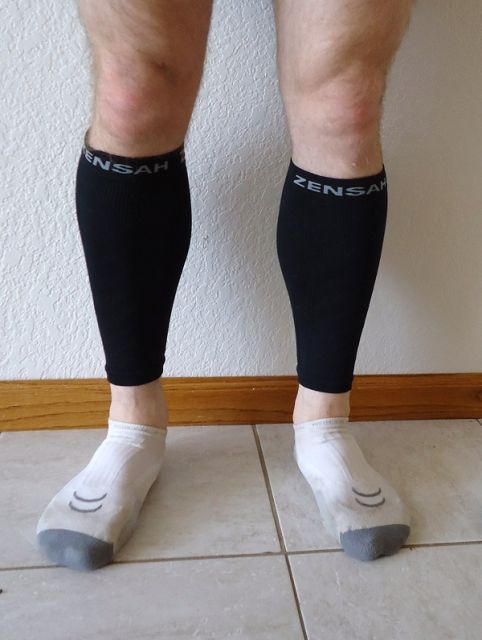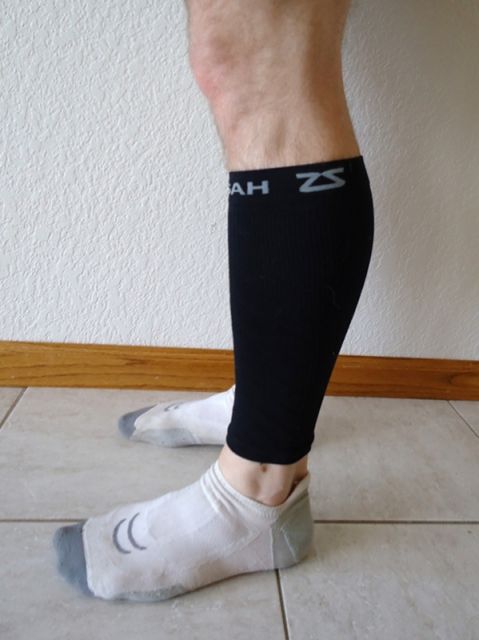Zensah’s Compression Leg Sleeves are an excellent option for runners who are under a heavy training load or who routinely have sore calves after workouts because they promote muscle recovery.
First Impressions
The compression sleeves look like someone cut off the all fabric on a tube sock below the top of the ankle. They are quite stretchy and are made with 90 percent nylon, 10 percent spandex.

Prior to this test, I had never used compression gear before. The basic principle behind compression clothing is to encourage blood flow by compressing blood vessels underneath the clothing. The increased pressure on a closed system speeds up blood flow, and this encourages recovery by minimizing inflammation and swelling. It also helps head off delayed onset muscle soreness.
Zensah claims to have figured out the right amount of compression – too little and the gear is ineffective, too much and the gear interferes with proper circulation. They also use a graduated compression – more on the bottom of a limb than at the top.
The product literature leaves much to be desired. It does not explain how compression gear works or why graduated compression is important; it simply offers a graphic about blood flow out of the leg increasing.

How I used the Leg Sleeves
I used the leg sleeves for every run from March 19 to April 2. Temperatures were between 40 and 20F.
During this period of time, I ran almost 110 miles, including logging 36 miles over three running sessions on March 26-27. I ran hard up and down long hills, did two long tempo runs, and did twenty 200-meter repeats at a hard pace on a track. I wore the sleeves pre-and post-workout and when I was generally relaxing around the house. I even wore them to work the day after I ran 10.5 hard miles in huarache-style sandals.
Recommendation
I recommend the leg sleeves for runners under a heavy training load or who regularly have sore calves post-workout. I intend to continue to use the sleeves through the season to gauge their effectiveness during and after ultramarathon-distance trail races.
When I wore the sleeves, my calves felt warmer. It was as if I was wearing a segment of tights. With the exception of a single run where I wore my sandals, I wore minimalist racing flats during every workout.
The sleeves work best with short socks that do not go up the calf. Socks that are longer need to be rolled down or put on top of the leg sleeve.
In the past, my calves could get sore during or after a hard run or one that involved a lot of uphills. For example, I often get pain in my calves when I push up a hill. This is usually caused because my foot is as less than a 90-degree angle to my shin when I land on the road. This stretch causes strain on calf muscles and Achilles’ tendons. Pain usually comes in the form of a cramp or gradual muscle soreness.
With two exceptions, my calves did not hurt during or after any of the above runs. And they should have. I pushed hard up a gradual two-mile hill during a particularly difficult long run and I should have had soreness during or after the run. Instead, I experienced no such thing.
I had pain in my calves twice. During a recent tempo run, I experienced soreness in my calves and Achilles’ when I ran up a long, gradual hill. But the pain dissipated once I returned to a normal pace on flat ground, and I was not sore the next morning.
I did have pain for two or three days following a 10.5 mile run in huarache sandals. This I attribute to two things unrelated to the leg sleeves: It was my second run of the year in sandals (and my second-longest run in them to-date) and I ran hard and fast, pushing the last two miles. I attribute this pain to overuse of the sandals when I wasn’t ready for it, and not to the run itself or the sleeves’s inability to head off the discomfort.
In the end, the sleeves will be a part of my running clothing for the remainder of the season. They have proven themselves so far, and I look forward to testing their performance in a race situation.
